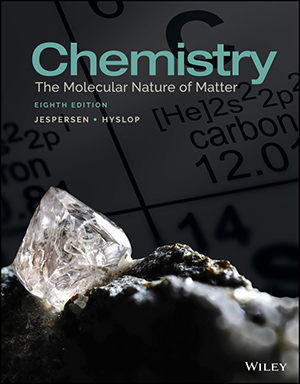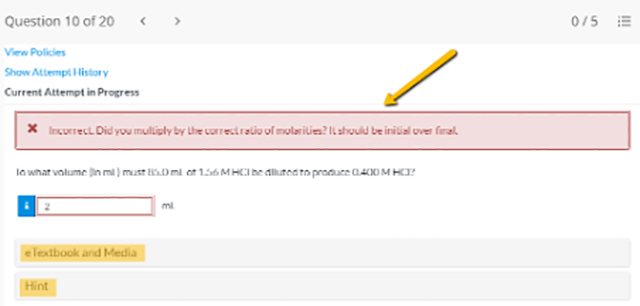
Chemistry: The Molecular Nature of Matter, 8th Edition
By Neil D. Jespersen, Alison Hyslop, and James Brady
Chemistry: The Molecular Nature of Matter, 8th Edition and WileyPLUS deliver a user-friendly experience and active engagement through enhanced visuals, giving students exposure to the wonders of chemistry in action. Readers are provided with the necessary practice, support, instruction and assessment required for learning and teaching the content of a general chemistry course. This course provides the forum for problem solving and concept mastery of chemical phenomena that leads to proficiency and success. The 8th edition continues to focus on analyzing and solving multi-concept problems and examples throughout. An increased emphasis has also been placed on the intimate relationship that exists between structure at the submicroscopic molecular level and the observable macroscopic properties of matter. The 8th edition provides students with clear, concise and easy-to-understand general chemistry instruction.
Schedule a Demo Request Instructor AccountWant to learn more about WileyPLUS? Click Here
The Mini Lecture Videos
cover major concepts introduced throughout the course to provide students with supplemental instruction. The videos can also be useful in multiple modes, including flipped classrooms.
Problem-Solving Videos
provide practice exercises to give students additional assistance with this vital skill. The questions are solved step-by-step with full explanations.

Answer-Specific Feedback
addresses issues at the point of learning. This feature removes the right/wrong response to numerical questions. If a student enters a wrong answer, they’ll get a short explanation of the error and how to correct it based on the mathematical process of the question.
QuickStart Assignments: Pre-created and author-vetted assignments that instructors can trust and easily assign.
Interactive Photographs come to life with video demonstration in WileyPLUS.
Instructor Resources
- Instructor’s Manual – contains lecture outlines, alternative syllabi, chapter overviews, suggestions for small group active learning projects, class discussions, tips for first-time instructors, class demonstrations, short writing projects, and relevant web links for each chapter. Contains answers to the pre-lab assignments and laboratory questions found in the Student Laboratory Manual.
- Test Bank – Contains more than 2,300 questions including, multiple-choice, true-false, short answer, fill in the blank and critical thinking problems. A full computerized version is also available with full editing to customize tests.
- New TestGen computerized test bank allows for quick creation of quizzes or tests. TestGen provides a variety of question types and also allows instructors to create their own questions.
- Instructor’s Solutions Manual contains worked-out solutions to all end-of-chapter problems.
- Digital Image Archive text website includes downloadable files of text images in JPEG format.
- Powerpoint Lecture Slides highlight key concepts and contain numerous clicker questions and include examples and illustrations. Includes images from the text.
- PowerPoint Slides with Text Images
- Personal Response Systems/“Clicker” Questions
Neil D. Jespersen is a Professor of Chemistry at St. John’s University in New York. He earned a B.S. with Special Attainments in Chemistry at Washington and Lee University (VA) and his Ph.D. in Analytical Chemistry with Joseph Jordan at The Pennsylvania State University. He has received awards for excellence in teaching and research from St. John’s University and the E. Emmit Reid Award in college teaching from the American Chemical Society’s Middle Atlantic Region. He chaired the Department of Chemistry for 6 years and has mentored the St. John’s student ACS club for over 30 years while continuing to enjoy teaching Quantitative and Instrumental Analysis courses, along with General Chemistry. He has been an active contributor to the Eastern Analytical Symposium, chairing it in 1991. Neil authors the Barrons AP Chemistry Study Guide; has edited two books on Instrumental Analysis and Thermal Analysis; and has four chapters in research monographs, 50 refereed publications, and 150 abstracts and presentations. He is active at the local, regional and national levels of the American Chemical Society, and served on the ACS Board of Directors and was named a Fellow of the ACS in 2013. When there is free time you can find him playing tennis, baseball, and soccer with four grandchildren, or traveling with his wife Marilyn.
Alison Hyslop received her BA degree from Macalester College in 1986 and her Ph.D. from the University of Pennsylvania under the direction of Michael J. Therien in 1998. Alison currently chairs the Department of Chemistry at St. John’s University, New York where she is an Associate Professor. She has been teaching graduate and undergraduate courses since 2000. She was a visiting Assistant Professor at Trinity College (CT) from 1998 to 1999. She was a visiting scholar at Columbia University (NY) in 2005 and in 2007 and at Brooklyn College in 2009, where she worked on research projects in the laboratory of Brian Gibney. Her research focuses on the synthesis and study of porphyrin based light harvesting compounds. When not in the laboratory, she likes to hike in upstate New York, and practice tae kwon do.
0. A Very Brief History of Chemistry
1. Scientific Measurements
2. Elements, Compounds, and the Periodic Table
3. The Mole and Stoichiometry
4. Molecular View of Reactions in Aqueous Solutions
5. Oxidation Reduction Reactions
6. Energy and Chemical Change
7. The Quantum Mechanical Atom
8. The Basics of Chemical Bonding
9. Theories of Bonding and Structure
10. Properties of Gases
11. Intermolecular Attractions and the Properties of Liquids and Solids
12. Mixtures at the Molecular Level: Properties of Solutions
13. Chemical Kinetics
14. Chemical Equilibrium
15. Acids and Bases, A Molecular Look
16. Acid–Base Equilibria in Aqueous Solutions
17. Solubility and Simultaneous Equilibria
18. Thermodynamics
19. Electrochemistry
20. Nuclear Reactions and Their Role in Chemistry
21. Metal Complexes
22. Organic Compounds, Polymers, and Biochemicals
Appendix A: Review of Mathematics
Appendix B: Answers to Practice Exercises and Selected Review Problems
Appendix C: Tables of Selected Data

